The global rigid food containers market is valued at USD 58.7 billion in 2025 and is slated to reach USD 94.7 billion by 2035, recording an absolute increase of USD 35.6 billion over the forecast period. This translates into a total growth of 60.6%, with the market forecast to expand at a CAGR of 4.9% between 2025 and 2035. The market size is expected to grow by nearly 1.61X during the same period, supported by increasing demand for convenient ready-to-eat meal packaging, growing adoption of portion-controlled food storage solutions in foodservice industries, and rising preference for durable container technologies across retail food distribution and quick-service restaurant applications.
Between 2020 and 2025, the market experienced robust growth, driven by increasing demand for food delivery packaging in quick-service restaurant industries and growing recognition of rigid food containers as essential storage solutions for prepared meals across retail, foodservice, institutional catering, and specialty food applications. The market developed as manufacturers recognized the potential for rigid food containers to provide superior product protection while maintaining food freshness and enabling stackable storage formats. Technological advancement in injection molding processes and material compound formulations began emphasizing the critical importance of maintaining container integrity and leak resistance in diverse food storage environments.
Between 2025 and 2030, the market is projected to expand from USD 58.7 billion to USD 75.2 billion, resulting in a value increase of USD 16.5 billion, which represents 46.3% of the total forecast growth for the decade. This phase of development will be shaped by increasing demand for takeaway and delivery packaging solutions, rising adoption of microwave-safe container technologies, and growing requirements for transparent containers with enhanced product visibility and merchandising capabilities. Food manufacturers are expanding their rigid container sourcing capabilities to address the growing demand for fresh produce packaging, deli food storage, and temperature-resistant meal container applications.
From 2030 to 2035, the market is forecast to grow from USD 75.2 billion to USD 94.7 billion, adding another USD 19.1 billion, which constitutes 53.7% of the ten-year expansion. This period is expected to be characterized by the expansion of advanced barrier coating technologies for container protection, the integration of modified atmosphere packaging compatibility features, and the development of enhanced material formulations with improved temperature resistance performance. The growing adoption of automated filling and sealing equipment will drive demand for rigid food containers with superior dimensional stability capabilities and compatibility with high-speed packaging lines across food processing facilities.
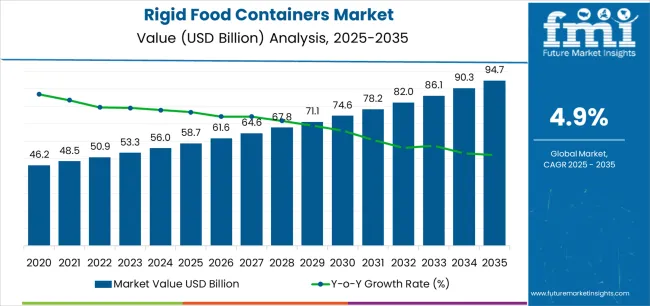
| Metric | Value |
|---|---|
| Estimated Value in (2025E) | USD 58.7 billion |
| Forecast Value in (2035F) | USD 94.7 billion |
| Forecast CAGR (2025 to 2035) | 4.9% |
Market expansion is being supported by the increasing global demand for convenient food packaging solutions and the corresponding need for container systems that can provide superior product protection and food preservation capabilities while enabling portion control and efficient storage across various retail food and foodservice distribution applications. Modern food processing facilities and restaurant operators are increasingly focused on implementing container solutions that can maintain food quality, prevent contamination, and provide consistent performance throughout complex supply chain networks. Rigid food containers' proven ability to deliver exceptional durability properties, enable product visibility through clarity, and support regulatory compliance make them essential packaging formats for contemporary prepared food and fresh produce operations.
The growing emphasis on food safety and hygiene standards is driving demand for rigid food containers that can support temperature maintenance requirements, improve consumer convenience, and enable advanced closure formats. Manufacturers' preference for containers that combine effective food protection with merchandising appeal and processing efficiency is creating opportunities for innovative rigid container implementations. The rising influence of meal kit delivery services and online grocery markets is also contributing to increased demand for rigid food containers that can provide leak resistance, stacking efficiency, and reliable performance across diverse product categories.
The rigid food containers market is poised for rapid growth and transformation. As industries across foodservice, retail food, institutional catering, fresh produce, and prepared meal delivery seek containers that deliver exceptional food protection, leak resistance, and consumer convenience, rigid food containers are gaining prominence not just as functional packaging but as strategic enablers of product freshness and operational efficiency.
Rising online food delivery consumption in Asia-Pacific and expanding meal kit markets globally amplify demand, while manufacturers are leveraging innovations in injection molding precision, barrier coating technologies, and advanced material compounds.
Pathways like microwave-safe features, compartmentalized meal designs, and application-specific barrier formulations promise strong margin uplift, especially in high-value segments. Geographic expansion and vertical integration will capture volume, particularly where local manufacturing capabilities and food industry proximity are critical. Regulatory pressures around food contact material requirements, hygiene standards, takeaway packaging regulations, and leak-proof sealing specifications give structural support.
The market is segmented by material type, container type, capacity, closure type, end-use application, and region. By material type, the market is divided into plastic (PP, PET, PS, HDPE), paperboard, aluminum, and others. By container type, it covers cups & bowls, tubs & trays, boxes & cartons, clamshells, and others. By capacity, it includes below 250ml, 250-500ml, 500-1000ml, and above 1000ml. By closure type, it is categorized into snap-on lids, hinged lids, separate lids, and lidless. By end-use application, it covers foodservice & restaurants, retail & supermarkets, institutional catering, fresh produce, and others. Regionally, the market is divided into North America, Europe, East Asia, South Asia & Pacific, Latin America, and the Middle East & Africa.
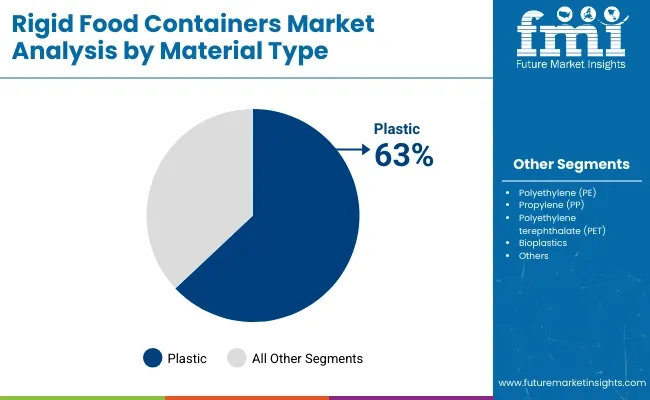
The plastic segment is projected to account for 62.3% of the rigid food containers market in 2025, reaffirming its position as the leading material category. Food processors and restaurant operators increasingly utilize plastic rigid food containers for their optimal compatibility with automated filling equipment, excellent clarity characteristics, and widespread adoption in deli salad, prepared meal, and fresh produce applications. The plastic container technology's established processing versatility and consistent molding performance directly address the industrial requirements for reliable food protection in high-volume packaging environments.
This material segment forms the foundation of modern food packaging operations, as it represents the container type with the greatest market penetration and established demand across multiple food categories and global markets. Manufacturer investments in enhanced barrier coating technologies and advanced polymer formulations continue to strengthen adoption among food processors and restaurant operators. With companies prioritizing food safety and operational efficiency, plastic rigid food containers align with both performance requirements and equipment compatibility objectives, making them the central component of comprehensive packaging strategies.
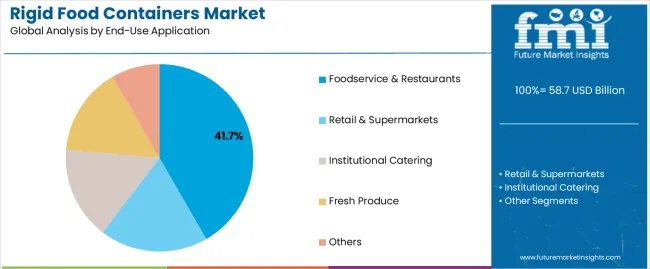
Foodservice and restaurant applications are projected to represent 41.7% of rigid food containers demand in 2025, underscoring their critical role as the primary industrial consumers of rigid container packaging for takeaway meals, delivery orders, and prepared food distribution. Restaurant operators prefer rigid food containers for their exceptional leak resistance capabilities, superior stacking integrity, and ability to prevent food spillage while ensuring consumer satisfaction with secure packaging. Positioned as essential container formats for modern quick-service restaurant and fast-casual dining operations, rigid food containers offer both functional advantages and cost efficiency benefits.
The segment is supported by continuous innovation in closure technologies and the growing availability of specialized compartment designs that enable meal separation with enhanced presentation performance and portion control customization. Foodservice operators are investing in automated dispensing systems to support large-volume rigid food container utilization and operational efficiency. As online food delivery becomes more prevalent and ghost kitchen operations increase, foodservice applications will continue to dominate the end-use market while supporting advanced container features and temperature maintenance strategies.
The rigid food containers market is advancing rapidly due to increasing demand for convenient takeaway packaging in foodservice industries and growing adoption of durable container solutions that provide superior food protection and leak resistance while enabling portion control across diverse restaurant and retail food distribution applications. The market faces challenges, including raw material price volatility, competition from flexible packaging alternatives, and the need for specialized molding equipment investments. Innovation in barrier coating capabilities and advanced material formulations continues to influence product development and market expansion patterns.
The growing adoption of breathable film systems, oxygen barrier coatings, and sophisticated ventilation designs is enabling manufacturers to produce rigid food containers with superior freshness retention, enhanced shelf life extension, and humidity control functionalities. Advanced MAP systems provide improved product quality while allowing more efficient fresh produce storage and consistent performance across various food categories and distribution channels. Manufacturers are increasingly recognizing the competitive advantages of freshness-preserving capabilities for product differentiation and premium market positioning.
Modern rigid food container producers are incorporating tamper-evident seals, breakable bands, and security closure technologies to enhance food safety, enable contamination prevention, and deliver value-added protection solutions to restaurant operators and retail food customers. These technologies improve consumer confidence while enabling new operational capabilities, including quality assurance, product integrity verification, and safety compliance. Advanced security integration also allows manufacturers to support food brands and regulatory requirements beyond traditional packaging approaches.
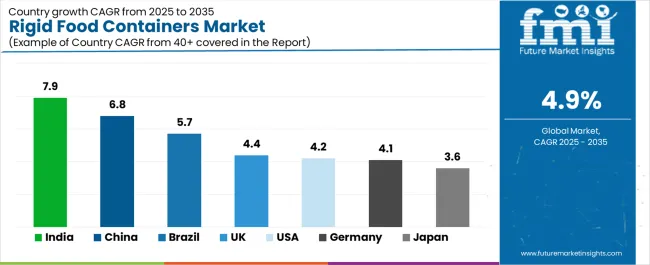
| Country | CAGR (2025-2035) |
|---|---|
| China | 6.8% |
| USA | 4.2% |
| India | 7.9% |
| Japan | 3.6% |
| Germany | 4.1% |
| Brazil | 5.7% |
| United Kingdom | 4.4% |
The rigid food containers market is experiencing strong growth globally, with India leading at a 7.9% CAGR through 2035, driven by the expanding foodservice industry, growing online food delivery platforms, and significant investment in food processing infrastructure development. China follows at 6.8%, supported by rapid urbanization growth, increasing takeaway consumption, and growing restaurant chain expansion. The USA shows growth at 4.2%, emphasizing meal kit innovation and convenience food packaging development. Brazil records 5.7%, focusing on quick-service restaurant expansion and growing prepared food consumption. Germany demonstrates 4.1% growth, prioritizing precision manufacturing standards and advanced container production excellence. Japan exhibits 3.6% growth, emphasizing quality control and convenience store packaging. The United Kingdom shows 4.4% growth, supported by food delivery platform expansion and ready meal innovation.
The report covers an in-depth analysis of 40+ countries, with top-performing countries highlighted below.
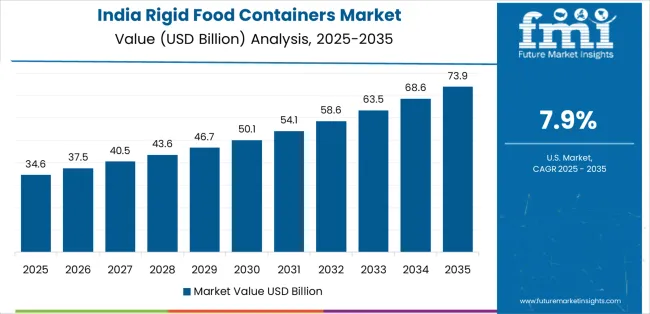
Revenue from rigid food containers in India is projected to exhibit exceptional growth with a CAGR of 7.9% through 2035, driven by expanding foodservice operations and rapidly growing online food delivery platforms supported by digitization policies promoting restaurant aggregator development. The country's strong position in food processing manufacturing and increasing investment in cold chain infrastructure are creating substantial demand for rigid food container solutions. Major restaurant chains and cloud kitchen operators are establishing comprehensive container sourcing capabilities to serve both dine-in packaging demand and delivery order markets.
Demand for rigid food containers in China is expanding at a CAGR of 6.8%, supported by the country's massive takeaway market, expanding restaurant chain activities, and increasing adoption of automated packaging solutions. The country's government initiatives promoting food safety standards and growing middle-class convenience consumption are driving requirements for advanced container capabilities. International suppliers and domestic manufacturers are establishing extensive production and distribution capabilities to address the growing demand for rigid food container products.
Revenue from rigid food containers in the USA is growing at a CAGR of 4.2%, supported by the country's thriving meal kit industry, strong emphasis on convenience packaging aesthetics, and robust demand for high-performance containers in prepared meal and fresh produce applications. The nation's mature foodservice sector and brand-focused operations are driving sophisticated compartmentalized container systems throughout the supply chain. Leading manufacturers and technology providers are investing extensively in molding equipment and barrier technologies to serve both domestic and international markets.
Demand for rigid food containers in Brazil is anticipated to expand at a CAGR of 5.7%, driven by the country's expanding fast-food industry, growing delivery platform penetration, and increasing investment in modern packaging facilities. Brazil's large domestic foodservice market and commitment to restaurant industry modernization are supporting demand for rigid food container solutions across multiple operational segments. Manufacturers are establishing comprehensive production capabilities to serve the growing domestic market and regional export opportunities.
Revenue from rigid food containers in Germany is expected to grow at a CAGR of 4.1%, supported by the country's precision engineering leadership, advanced manufacturing capabilities, and strategic focus on high-quality container production. Germany's technical excellence and quality focus are driving demand for rigid food containers in foodservice operations, retail food packaging, and specialty fresh produce applications. Manufacturers are investing in comprehensive automation capabilities to serve both domestic food processors and international specialty markets.
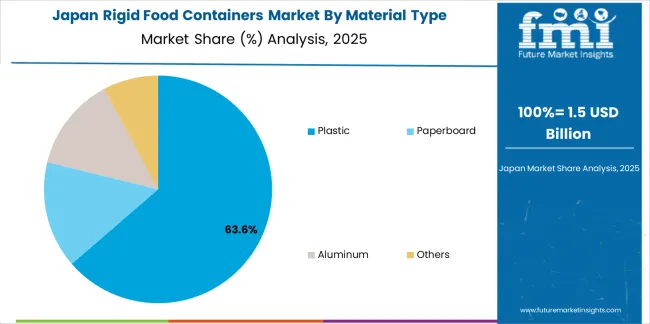
Demand for rigid food containers in Japan is expanding at a CAGR of 3.6%, driven by the country's expertise in precision manufacturing, emphasis on quality assurance, and strong position in convenience store and prepared meal packaging. Japan's established container technology capabilities and commitment to excellence are supporting investment in advanced production technologies throughout major manufacturing centers. Industry leaders are establishing comprehensive quality systems to serve convenience store chains and food processors.
Revenue from rigid food containers in the United Kingdom is growing at a CAGR of 4.4%, supported by the country's food delivery platform concentration, growing ready meal sector, and strategic position in European foodservice markets. The UK's convenience food capabilities and integrated distribution infrastructure are driving demand for high-quality rigid food containers in takeaway packaging, meal kit applications, and fresh produce distribution. Leading manufacturers are investing in specialized capabilities to serve the stringent requirements of food delivery and retail food industries.
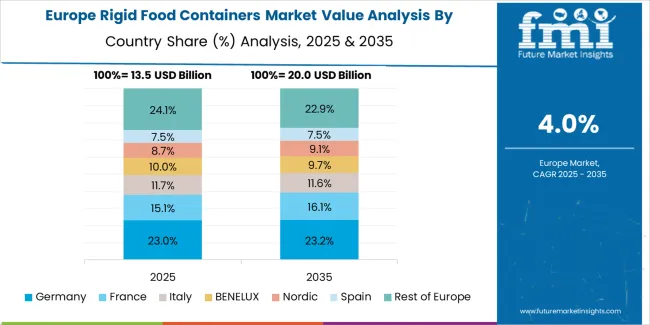
The rigid food containers market in Europe is projected to grow from USD 15.8 billion in 2025 to USD 26.2 billion by 2035, registering a CAGR of 5.2% over the forecast period. Germany is expected to maintain its leadership position with a 26.5% market share in 2025, declining slightly to 26.0% by 2035, supported by its strong precision manufacturing base, advanced container production capabilities, and comprehensive foodservice and retail food sector serving diverse rigid container applications across Europe.
France follows with a 19.5% share in 2025, projected to reach 20.0% by 2035, driven by robust demand for rigid food containers in bakery packaging, fresh produce applications, and prepared meal production, combined with established food processing infrastructure and export-oriented packaging expertise. The United Kingdom holds a 18.0% share in 2025, expected to reach 18.5% by 2035, supported by strong food delivery platform growth and expanding ready meal activities. Italy commands a 15.5% share in 2025, projected to reach 16.0% by 2035, while Spain accounts for 10.5% in 2025, expected to reach 11.0% by 2035. Poland maintains a 5.0% share in 2025, growing to 5.2% by 2035. The Rest of Europe region, including Nordic countries, Eastern Europe, Belgium, Netherlands, and other nations, is anticipated to maintain momentum, with its collective share moving from 5.0% to 3.3% by 2035, attributed to increasing foodservice operations in Eastern Europe and growing food processing activities in Nordic countries implementing advanced container programs.
The Rigid Food Containers Market comprises roughly 25 to 35 players with moderate concentration, where the top three companies account for about 24 percent of global value, leveraging wide manufacturing footprints and strong retail packaging relationships. Amcor plc leads with approximately 9 percent share through diversified rigid packaging formats, multilayer barrier technologies, and large-scale contract manufacturing. Berry Global Inc. and Sealed Air Corporation hold the next largest shares, supported by broad product ranges and global distribution.
Market leaders such as Amcor, Berry Global, and Sealed Air focus on innovation in barrier performance, lightweighting, and recyclability to meet food safety standards and sustainability commitments from major brand owners. Their competitive advantages include integrated design services, regional manufacturing scale that reduces lead times, and collaborative R&D with food manufacturers to tailor packaging for shelf life extension and supply chain efficiency. They also provide validated regulatory support for food contact and traceability systems.
Other significant players including Huhtamaki Oyj, Dart Container Corporation, Pactiv Evergreen Inc., Sonoco Products Company, Greiner Packaging, Anchor Packaging, and Genpak compete by offering specialized formats, regional responsiveness, and price-competitive solutions. Smaller converters and niche suppliers differentiate through fast prototyping, personalized branding options, and specialized materials such as compostable or mono-polymer systems. Market growth is shaped by shifting retailer sustainability requirements, the need for extended product shelf life, and the ability of suppliers to deliver scalable, certified packaging solutions that align with evolving consumer and regulatory expectations.
| Items | Values |
|---|---|
| Quantitative Units (2025) | USD 58.7 Billion |
| Material Type | Plastic (PP, PET, PS, HDPE), Paperboard, Aluminum, Others |
| Container Type | Cups & Bowls, Tubs & Trays, Boxes & Cartons, Clamshells, Others |
| Capacity | Below 250ml, 250-500ml, 500-1000ml, Above 1000ml |
| Closure Type | Snap-on Lids, Hinged Lids, Separate Lids, Lidless |
| End-Use Application | Foodservice & Restaurants, Retail & Supermarkets, Institutional Catering, Fresh Produce, Others |
| Regions Covered | North America, Europe, East Asia, South Asia & Pacific, Latin America, Middle East & Africa |
| Countries Covered | United States, Canada, United Kingdom, Germany, France, China, Japan, South Korea, India, Brazil, Australia and 40+ countries |
| Key Companies Profiled | Amcor plc, Berry Global Inc., Sealed Air Corporation, Huhtamaki Oyj, Dart Container Corporation, Pactiv Evergreen Inc., Sonoco Products Company, Greiner Packaging, Anchor Packaging LLC, Genpak LLC |
| Additional Attributes | Dollar sales by material type and end-use application category, regional demand trends, competitive landscape, technological advancements in injection molding systems, barrier coating development, closure design innovation, and supply chain integration |
The global rigid food containers market is estimated to be valued at USD 58.7 billion in 2025.
The market size for the rigid food containers market is projected to reach USD 94.7 billion by 2035.
The rigid food containers market is expected to grow at a 4.9% CAGR between 2025 and 2035.
The key product types in rigid food containers market are plastic , paperboard, aluminum and others.
In terms of end-use application, foodservice & restaurants segment to command 41.7% share in the rigid food containers market in 2025.






Our Research Products

The "Full Research Suite" delivers actionable market intel, deep dives on markets or technologies, so clients act faster, cut risk, and unlock growth.

The Leaderboard benchmarks and ranks top vendors, classifying them as Established Leaders, Leading Challengers, or Disruptors & Challengers.

Locates where complements amplify value and substitutes erode it, forecasting net impact by horizon

We deliver granular, decision-grade intel: market sizing, 5-year forecasts, pricing, adoption, usage, revenue, and operational KPIs—plus competitor tracking, regulation, and value chains—across 60 countries broadly.

Spot the shifts before they hit your P&L. We track inflection points, adoption curves, pricing moves, and ecosystem plays to show where demand is heading, why it is changing, and what to do next across high-growth markets and disruptive tech

Real-time reads of user behavior. We track shifting priorities, perceptions of today’s and next-gen services, and provider experience, then pace how fast tech moves from trial to adoption, blending buyer, consumer, and channel inputs with social signals (#WhySwitch, #UX).

Partner with our analyst team to build a custom report designed around your business priorities. From analysing market trends to assessing competitors or crafting bespoke datasets, we tailor insights to your needs.
Supplier Intelligence
Discovery & Profiling
Capacity & Footprint
Performance & Risk
Compliance & Governance
Commercial Readiness
Who Supplies Whom
Scorecards & Shortlists
Playbooks & Docs
Category Intelligence
Definition & Scope
Demand & Use Cases
Cost Drivers
Market Structure
Supply Chain Map
Trade & Policy
Operating Norms
Deliverables
Buyer Intelligence
Account Basics
Spend & Scope
Procurement Model
Vendor Requirements
Terms & Policies
Entry Strategy
Pain Points & Triggers
Outputs
Pricing Analysis
Benchmarks
Trends
Should-Cost
Indexation
Landed Cost
Commercial Terms
Deliverables
Brand Analysis
Positioning & Value Prop
Share & Presence
Customer Evidence
Go-to-Market
Digital & Reputation
Compliance & Trust
KPIs & Gaps
Outputs
Full Research Suite comprises of:
Market outlook & trends analysis
Interviews & case studies
Strategic recommendations
Vendor profiles & capabilities analysis
5-year forecasts
8 regions and 60+ country-level data splits
Market segment data splits
12 months of continuous data updates
DELIVERED AS:
PDF EXCEL ONLINE
Breaking Down Market Share in Rigid Food Containers
Rigid Food Packaging Market Size, Share & Forecast 2025 to 2035
Fast Food Containers Market Trends – Growth & Forecast 2025 to 2035
Insulated Food Containers Market
Disposable Food Containers Market Size and Share Forecast Outlook 2025 to 2035
Collapsible Rigid Containers Market Size and Share Forecast Outlook 2025 to 2035
Competitive Landscape of Collapsible Rigid Containers Providers
Collapsible Food Packaging Containers Market
Demand for Collapsible Rigid Containers in USA Size and Share Forecast Outlook 2025 to 2035
Food & Beverage OEE Software Market Size and Share Forecast Outlook 2025 to 2035
Food Grade Crosslinked Polyvinylpolypyrrolidone (PVPP) Market Size and Share Forecast Outlook 2025 to 2035
Food Grade Cassia Gum Powder Market Size and Share Forecast Outlook 2025 to 2035
Food Grade Dry Film Lubricant Market Size and Share Forecast Outlook 2025 to 2035
Rigid Foam Market Forecast Outlook 2025 to 2035
Rigid Box Market Forecast and Outlook 2025 to 2035
Foodservice Equipment Market Analysis - Size, Share, and Forecast Outlook 2025 to 2035
Food Basket Market Forecast and Outlook 2025 to 2035
Rigid Sleeve Boxes Market Size and Share Forecast Outlook 2025 to 2035
Food Grade Tremella Polysaccharide Market Size and Share Forecast Outlook 2025 to 2035
Food Sorting Machine Market Size and Share Forecast Outlook 2025 to 2035

Thank you!
You will receive an email from our Business Development Manager. Please be sure to check your SPAM/JUNK folder too.
Chat With
MaRIA